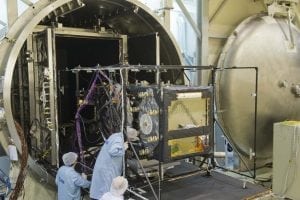New Galileo Satellite Completes Five Weeks of Simulated Space Conditions
[Via Satellite 12-2-13] After completing a battery of tests, ESA’s newest Galileo satellite was removed from the Phenix chamber at the ESA’s ESTEC test center in the Netherlands. The thermal vacuum testing was used to assure that Galileo’s two dissimilar atomic clocks, which are accurate to a few billionths of a second, will still work perfectly in space.
The thermal-vacuum test was the culmination of a long session of testing stretching back to mid-May, when the satellite first arrived at ESTEC. These included simulating the violence of launch and checking electromagnetic compatibility to ensure that the various elements do not interfere with the rest of the satellite. Thermal control is a critical design concern, seeking to maintain a set operating temperature within the body of the satellite. This is why some of Galileo’s surfaces are covered with reflective mirrors while others are shrouded in black multilayer insulation. Heaters warm up some areas of the satellite that become too cold, while heat pipes threaded through the structure carry away unwanted heat to the radiators, cooling other areas.
A second Galileo has also been undergoing the same rigors at the site plus a vibration and shock test to reproduce its separation from its launcher. Thermal–vacuum testing on this second model will begin early next year.
The sibling satellites will be launched together on a Soyuz rocket from Europe’s Spaceport in French Guiana by mid-2014. These are the first two ‘Full Operational Capability’ (FOC) satellites, following on from the four already in orbit. A total of 22 FOC satellites are scheduled, built by OHB in Germany with navigation payloads from Surrey Satellite Technology in the UK.
